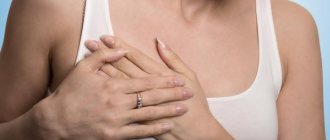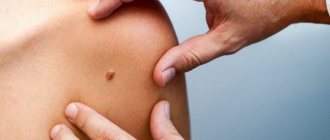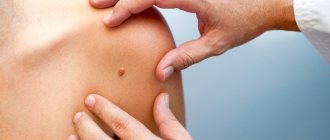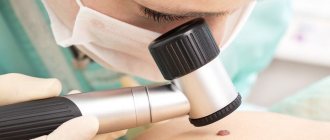Causes and mechanisms
In normal condition, the skin of the breast is clean, there are no discharges or rashes on it. White nipples can occur during pregnancy, when the gland, under the influence of prolactin, produces colostrum. This is not yet full-fledged milk; at first it is transparent, but soon acquires a white tint and a thick consistency.
Increased lactation after the birth of a child is another situation when the nipples may become covered with milk. But with regular natural feeding of the baby, this does not cause problems. Fordyce granules do not pose any danger - an individual feature associated with the close location of the sebaceous glands to the surface of the skin.
Of course, white spots on the nipples also occur in pathological conditions. Of these, the following should be noted:
- Lactostasis.
- Galactorrhea.
- Candidiasis (thrush).
- Tumors.
We cannot completely exclude the fact that a blister on the nipple may be a manifestation of herpes, and a blister may be an insect bite or an allergic reaction. Each situation requires careful analysis, because only through a full diagnosis can you determine the cause of what is happening and not miss the pathology.
Whitish spots or bumps in the peripapillary area are not uncommon. They can occur for physiological reasons or due to certain diseases.
Thrush on the chest
Breastfeeding is a very important process, which is sometimes fraught with difficulties. One possible problem is nipple candidiasis, which can cause discomfort for mother and baby.
Cause of candidiasis
The causative agent of thrush is the fungus Candida albicans. After it penetrates the damaged skin of the nipples, inflammation begins. One of the most common causes of candidiasis is the reaction of the female or child’s body to taking antibiotics. In addition to pathogenic microflora, such drugs also destroy beneficial bacteria, resulting in favorable conditions for the active proliferation of fungi. Often, nipple thrush occurs in parallel with oral candidiasis in infants.
How to treat
Before prescribing a nursing mother a course of drug therapy, the doctor may take a smear to confirm the infection. If the diagnosis of candidiasis is confirmed, the woman will be prescribed antifungal treatment. At the same time, medications will have to be given to the child, since pathogenic microorganisms multiply rapidly, and thrush easily spreads by touching.
Despite the fact that a woman needs to use medications, breastfeeding can and should be continued. This is due to the fact that in mild cases, it is sufficient to use external medications for the lesions, which is carried out after feeding. In advanced forms of candidiasis, mothers may be prescribed medications for systemic use (tablets). In this case, the issue of breastfeeding should be discussed with your doctor.
To prevent the spread of fungal infection during treatment, you must adhere to the following rules:
1. Mom should wash her hands thoroughly after any contact with the mammary glands, changing diapers, or applying medicine to the breast.
2. All family members must use personal towels.
3. Breast pads should be changed as often as possible.
4. All toys, pacifiers, pacifiers, and objects that the baby can put in his mouth must be sterilized or thoroughly washed.
5. Bed linen should be washed at the highest possible temperature, and after drying it should be ironed.
6. If a mother with nipple thrush expresses milk, it should not be given to the baby until the course of therapy has been completed, as there is a risk of re-infection. Low temperatures cannot destroy the fungus, so milk should not be frozen.
Main symptoms of candidiasis
You can suspect the development of thrush based on the characteristic symptoms. There is pain in the nipples or breasts, which does not go away for a long time after feeding. Visually, redness of the skin in the nipple area, rash and peeling are detected, and itching is disturbing.
In children, candidiasis manifests itself in the form of a whitish, cheesy coating on the oral mucosa, which cannot be removed with a napkin. A white film may appear on the lips, and anxiety increases during breastfeeding. In some cases, thrush is accompanied by diaper dermatitis.
If a woman experiences pain in one breast or nipple, an increase in body temperature, or a red spot on one of the mammary glands, she should immediately go to the hospital for examination, since these symptoms are not typical for candidiasis.
Pathological processes with changes in nipple color
So, we found out what normal nipples should be, and that for the most part the white color does not threaten anything, although it requires consultation with a specialist. Now let's find out what changes in nipple color cannot be ignored.
- Blue nipples in a nursing woman indicate that you are not breastfeeding your baby correctly. If the nipples turn blue in a non-breastfeeding woman, this can be a joyful harbinger of pregnancy, subject to a delay in menstruation, increased temperature in the pelvic area, as well as breast swelling (as before menstruation and increased sensitivity). The “path” from the navel to the lower abdomen is still darker. But, if to all this there is also pain in the lower abdomen, and the chest begins to turn red, pain appears, discharge from the nipple and the areolas turn blue, or spots appear on them - you need to urgently contact a specialist without hesitation, immediately after you it was noticed!
- The same should be done if you find purple nipples. The appearance of bluish or purple coloration of the nipples may indicate disorders in the pulmonary circulation, namely diseases of the lungs or heart.
Changing the color of the nipples in pregnant and lactating women
If we said that women are often very scrupulous about their health, then if we talk about pregnant and lactating women, it is worth multiplying this by two, or even three. The female body undergoes incredible changes during pregnancy. During this period, women may wonder: “What color are pregnant nipples?” They look for pictures on the Internet and talk about these topics with “experienced” friends. With the onset of pregnancy, the nipples darken, and sometimes their shade even becomes blue-black. It should be noted that in the third trimester, women note that their nipples turn white. The fact is that during this period colostrum begins to be released, which initially has a transparent consistency, and closer to childbirth it acquires a white tint. Therefore, if your nipples turn white before giving birth, you should know that everything is going as usual.
What are the white dots in the nipple area?
White dots can be:
- single or multiple;
- filled with or without content;
- located around the areolas or on the nipples themselves.
Usually, white dots do not appear “in their pure form” on the nipple, areola or around it, but rather flat whitish formations. More often these are tubercles, nodules or pustules.
Spots also appear on the nipples, for example, with uneven coloring of the SAC area (nipple and areola combined). And then small white dots or quite visible spots are scattered across the pink areola. This cosmetic defect can be easily corrected with tattooing.
Flat formations include vitiligo (disappearance of pigmentation). It is the nipples that this disease rarely affects, but the phenomenon is not excluded. In some articles, vitiligo is described as Fordyce granules, but this is not so; we will talk about the granules below.
Signs of whitish formations in the area of SAH
| Cause | Additional signs |
| Uneven pigmentation of the nipple | No |
| Vitiligo | A contour rim (zone of hyperpigmentation) around the lesion. Dyschromia on other parts of the body. |
| Bacteria | Purulent contents of a white spot. When acne appears in men, women and teenagers, one pimple (including exclusively on the nipple) or many whiteheads may form. |
| Fordyce granules | Itching and burning. In women, increased discomfort before and during menstruation (this is a characteristic sign of pathology). Long-term course (over 10 years). |
| Candidiasis | Whitish coating in the affected area. Itching and burning of the SAH area. Pain during hepatitis B. Erosions and ulcers, maceration (softening and separation of skin fibers). Hyperemia around the SAH. In non-breastfeeding women, signs of candidiasis intensify before menstruation. Why? Because sex hormones, rampant during this period, stimulate the growth of the fungus. |
| Montgomery tubercles | No |
| Blockage of the milk ducts during breastfeeding (lactostasis) | With lactostasis: Feeling of fullness in the chest. Pain when feeding. Slight redness of the breast skin in the area of the blockage. Lumps in the mammary gland. With the development of mastitis: high body temperature; severe discomfort; sharp jerking pain; severe redness on the skin over the site of stagnation; signs of intoxication (headache, weakness, nausea). |
Depigmentation
The problem of the appearance of white spots around the nipples as a symptom of vitiligo requires separate consideration.
Vitiligo is a disease of autoimmune origin. In such cases, the causes of the disease are unclear. The following actions will help reduce the consequences of the body’s struggle with its own cells:
- Avoiding stress
- Normalization of the gastrointestinal tract and liver
- Regular massage and other relaxing treatments
- Increasing immunity by taking vitamin complexes and immunomodulators
Treatment options
Treatment of white dots that have formed on the nipples depends on the cause of their appearance. For example, if the milk duct is blocked, the problem may resolve on its own.
While suckling at the breast, the baby can independently dissolve the plug, however, if it is small. If the plug persists for 3-5 days, it is accompanied by pain, which requires specific therapy:
- changes in the baby's posture during feeding, which causes a deeper latch on the nipple;
- eliminating the cessation of feeding the child, which will avoid even greater stagnation of milk;
- applying a compress to the nipple, for example, a towel soaked in warm water;
- taking a warm shower every day and often before putting your baby to the breast;
- using a sterile needle - piercing the white dot with further expressing milk or applying the baby to the breast;
- warming the breast in warm water and lubricating the nipple with vegetable oil to remove the plug.
If plugs constantly occur, especially in large quantities, you need to contact a mammologist who prescribes ultrasound treatment and taking Lecithin.
How to remove white dots if they are Fordyce granules? In this case, cryotherapy, electrocoagulation, and laser treatment help. After exposure to such methods, dry crusts remain in place of the white dots, which fall off on their own, leaving not a trace behind.
More serious causes of white spots on the nipples of the mammary glands require other specific therapy. If you manage to detect the corresponding symptoms, you should not self-medicate, but should immediately consult a doctor.
Features of treatment for certain diseases
- The development of a fungal infection on the mammary gland: both the nursing woman and the child she is breastfeeding require antifungal therapy (for the woman - in the form of tablets and local remedies, for the child - only in the form of local remedies).
- Development of herpes infection: in this case, treatment is also prescribed for both mother and child using systemic or local antiviral drugs.
- The presence of a subthreshold abscess: antibacterial therapy is prescribed, and in case of prolonged non-healing, surgical intervention is prescribed, which consists of suctioning purulent masses from the tissues or involves complete removal of the duct.
White spots in early pregnancy
A short time after pregnancy, women notice the appearance of specific pimples and spots around the nipples. The glands located in these tubercles around the nipples respond to changes in hormonal levels and begin to produce a special oily substance, maintaining the softness and elasticity of the skin of the nipples.
Scientists believe that the substance produced by Montgomery's tubercles attracts breastfed babies. They help him find the nipple when the mother begins to feed the baby for the first time. In addition, the secretion of the glands serves as a lubricant and protects the surface of the nipple and the entrance to the milk ducts from germs.
Changes in the size and number of visible Montgomery tubercles on the nipple are considered one of the earliest indicators of pregnancy. Active secretion production makes the tubercle look like a small bump with a white or yellowish top.
Montgomery's tubercles may enlarge and turn white regardless of pregnancy. The reasons for their manifestation may be:
- Hormonal changes before and during menstruation
- Taking oral contraceptives
- Menopause
- Other changes in hormonal profile
The manifestations of Montgomery tubercles near the nipple are painless and do not require treatment when they occur. However, it is not recommended to pierce the surface or squeeze out the contents of the tubercle due to the risk of infection. Painful sensations in the nipples and redness of the Montgomery tubercles indicate infection inside the glands and serve as a reason for contacting a medical facility.
Montgomery tubercles that do not disappear after childbirth and cessation of breastfeeding can be removed surgically. However, after this procedure, mini-scars will remain on the nipples. The following steps will help reduce the size of nipple bumps:
- Applying a warm, damp towel to the areola every day for 20 minutes (the towel should always be warm).
- The use of creams containing celandine, aloe vera, shea butter or cocoa butter.
- Increasing the amount of water consumed and reducing sugar intake.
- Following a diet will help avoid blockage of the Montgomery glands and their subsequent swelling.
Congenital depigmentation of the nipple
Nipples develop white, as a rule, in two cases:
- If you have vitiligo. Vitiligo is a disease characterized by the disappearance of melanin in certain areas of the skin and hair. This is not physically felt at all, but only has a cosmetic effect - light spots, which over time can either disappear or unite, increasing in volume. Vitiligo can be either genetic or acquired. The acquired form occurs as a result of exposure to certain chemical and medicinal compounds, as well as autoimmune, endocrinological and neurotrophic factors, disorders of melanogenesis, plus stress, chronic diseases of internal organs and skin, constant contact of the skin with synthetic tissues.
- Albinism. Albinism is a congenital absence of melanin, that is, the entire body becomes snow-white, including the chest.
Treatment of white spots on the areola and nipple
Treatment for white spots in the area of SAH depends on the cause of the change. For example, uneven coloration of the nipple is corrected in a tattoo parlor. Enlarged Montgomery tubercles cannot be treated in any way. For candidiasis, specific therapy is carried out with antimycotics: locally (nystatin ointment, candida solution) or systemic drugs Defflucan once (consultation with a doctor is required!).
Fordyce granules are removed using laser or cryocorrection. Prevent by applying Retin-A cream and jojoba oil. For purulent infections, pimples are treated with local antiseptics and antibiotics in the form of a cream.
With lactostasis, the breasts are strained, before feeding, take a warm shower or cover the bust with an ironed towel, and adjust the feeding regimen. For purulent mastitis, surgery is indicated.
This concludes our review of the topic, says goodbye to you and invites you to visit our site again. We will be glad if you subscribe to our newsletter and invite your friends and acquaintances to our site.
Painful white spots with lactostasis
Blockage of the milk ducts is accompanied by redness and inflammation of the nipple, as well as an increase in body temperature. This occurs due to stagnation of milk in the mammary gland, manifested by the formation of an inflamed growth with white contents, which begins to hurt more and more.
A woman tries to avoid breastfeeding, but it is not recommended not to breastfeed if lactostasis develops. You can help the ducts free themselves.
To do this you should:
- Apply a warm compress to your breasts before feeding.
- After feeding, apply a cold compress to reduce pain.
- Squeeze a little milk before feeding to soften the nipple.
- During feeding, position the baby so that his lower jaw is near the blocked duct.
If the clogged canal could not be freed from stagnant milk on your own, you should seek help from a specialist. The problem of lactostasis can be solved by puncturing the inflamed, clogged area in the middle of the white spot.
Most types of white plaque around the nipples, as well as the phenomenon of white nipples, occur during lactation and disappear during the implementation of an established feeding pattern. With the adjusted nutritional regimen, the milk ducts are promptly cleared of milk.
Correct positioning of the baby during feeding allows the mother to receive additional stimulation and massage the areola and nipple using the baby's sucking movements.
To prevent the occurrence of lactostasis you should:
- During feeding, make sure that the breast is completely emptied before moving on to the other breast.
- Express excess milk (a special bottle is suitable for storage).
- Monitor the correct position of the baby during feeding.
- Change the baby's position with each new feeding.
- Avoid wearing a tight bra (tightness is indicated by a red stripe on the skin on the side of the chest).
- Position car seat belts, as well as belts of children's portable devices, so that they do not compress the mammary glands of a nursing woman.










